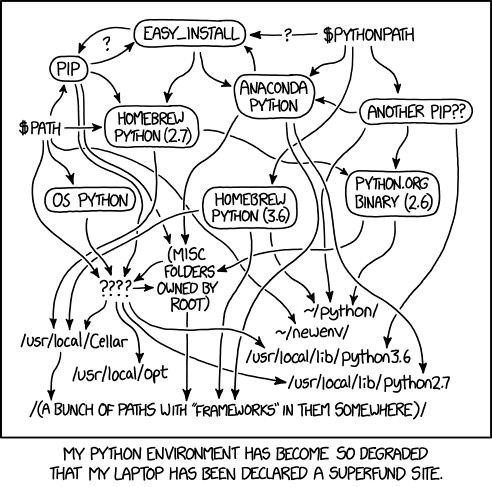I'm still working on getting pyenv in my bloodstream. It seems like totally the right tool for having different versions of Python available on macOS that don't suddenly break when you run brew upgrade periodically. But every thing I tried failed with an error similar to this:
By default MacOS ships with Python-2. But, I guess most of us have long back started to work with Python-3 and it is very irritating to run python3 every time instead of python in terminal. In this video, I walk you through the process of installing Python 3 and properly setting it up so that it becomes the default instead of the System Python 2. Problems using zsh with Catalina, Python/Python3, pip/pip3, PATH, zshrc, etc. I recently updated to Catalina and the default zsh. I probably messed up paths during the transition, and I'm currently trying to sort out the locations of Python3.7, pip3, the command-line PATH and my zshrc file. It looks as if there are potentially redundant files. Maria Campbell provides a post on installing the latest version of Python on Mac OS Catalina and overriding the old default pre-installed version. And it even uses Homebrew and not some gnarly steps. I finally did it. I successfully installed Python version 3.7.7 via Homebrew on my Mac laptop with OS Catalina installed.

I read through the Troubleshooting FAQ and the 'Common build problems' documentation. xcode was up to date and I had all the related brew packages upgraded. Nothing seemed to work.
Until I saw this comment on an open pyenv issue: 'Unable to install any Python version on MacOS'
All I had to do was replace the 10.14 for 10.15 and now it finally worked here on Catalina 10.15. So, the magical line was this:
Hopefully, by blogging about it you'll find this from Googling and I'll remember the next time I need it because it did eat 2 hours of precious evening coding time.
Related posts
- Previous:
- redirect-chain - Getting a comfortable insight input URL redirects history14 February 2020
- Next:
- How to install Node 12 on Ubuntu (Eoan Ermine) 19.1008 April 2020
- Related by category:
- How much faster is Redis at storing a blob of JSON compared to PostgreSQL?28 September 2019Python
- Best practice with retries with requests19 April 2017Python
- Fastest way to find out if a file exists in S3 (with boto3)16 June 2017Python
- Interesting float/int casting in Python25 April 2006Python
- Fastest way to unzip a zip file in Python31 January 2018Python
Mac OS X comes with Python 2.7 out of the box.
You do not need to install or configure anything else to use Python 2. Theseinstructions document the installation of Python 3.
The version of Python that ships with OS X is great for learning, but it’s notgood for development. The version shipped with OS X may be out of date from theofficial current Python release,which is considered the stable production version.
Doing it Right¶
Let’s install a real version of Python.
Before installing Python, you’ll need to install GCC. GCC can be obtainedby downloading Xcode, the smallerCommand Line Tools (must have anApple account) or the even smaller OSX-GCC-Installerpackage.
Note
If you already have Xcode installed, do not install OSX-GCC-Installer.In combination, the software can cause issues that are difficult todiagnose.
Note
If you perform a fresh install of Xcode, you will also need to add thecommandline tools by running xcode-select--install on the terminal.
Catalina Python3 Tkinter
While OS X comes with a large number of Unix utilities, those familiar withLinux systems will notice one key component missing: a package manager.Homebrew fills this void.

To install Homebrew, open Terminal oryour favorite OS X terminal emulator and run

The script will explain what changes it will make and prompt you before theinstallation begins.Once you’ve installed Homebrew, insert the Homebrew directory at the topof your PATH environment variable. You can do this by adding the followingline at the bottom of your ~/.profile file
If you have OS X 10.12 (Sierra) or older use this line instead
Now, we can install Python 3:
This will take a minute or two.
Pip¶
Homebrew installs pip pointing to the Homebrew’d Python 3 for you.
Working with Python 3¶
At this point, you have the system Python 2.7 available, potentially theHomebrew version of Python 2 installed, and the Homebrewversion of Python 3 as well.
will launch the Homebrew-installed Python 3 interpreter.
will launch the Homebrew-installed Python 2 interpreter (if any).
will launch the Homebrew-installed Python 3 interpreter.
If the Homebrew version of Python 2 is installed then pip2 will point to Python 2.If the Homebrew version of Python 3 is installed then pip will point to Python 3.
The rest of the guide will assume that python references Python 3.
Pipenv & Virtual Environments¶
The next step is to install Pipenv, so you can install dependencies and manage virtual environments.

A Virtual Environment is a tool to keep the dependencies required by different projectsin separate places, by creating virtual Python environments for them. It solves the“Project X depends on version 1.x but, Project Y needs 4.x” dilemma, and keepsyour global site-packages directory clean and manageable.
For example, you can work on a project which requires Django 1.10 while alsomaintaining a project which requires Django 1.8.
So, onward! To the Pipenv & Virtual Environments docs!
Catalina Python 3d
This page is a remixed version of another guide,which is available under the same license.